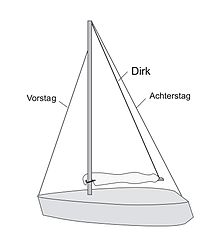Backstay

The backstay of a sailing ship is a rope attached to the mast top or the top of the mast , usually made of wire, which - attached to the stern - prevents the mast from tipping over forwards. Opposite the backstay attacks - at the top of the mast, in modern constructions usually just below it - the forestay , which secures the mast accordingly to the rear.
In addition to this end of the backstay is in an on voltage 7/8 rig the shape of the mainsail trimmed , since aft by increasing the voltage of the backstay of the masthead by and the central part of the mast moves arcuately forward. If the sail is "bulbous", this means that the sail is curved too much in the middle of the surface. By tightening (tensioning) the backstay, the mast can be bent so that the sail is trimmed flatter and thus provides a better angle of attack at the front. This allows you to run at a more acute angle to the wind, "more altitude". Furthermore, harmful heeling forces are reduced and the force generated by the sail is reduced, but better aligned for the desired direction of travel "high on the wind". In addition, the tension also eliminates the sag in the forestay with similar effects on the profile of the headsail. At courses less close to the wind (and in the harbor) you relax the backstay partially without giving up the mast-supporting effect. Occasionally a section of the backstay is electrically isolated and is used as an antenna for radio systems ( border wave , short wave ).
Hydraulics , a spindle drive or a tackle are used for tensioning and trimming .
Stages and shrouds are also referred to as standing rigging .